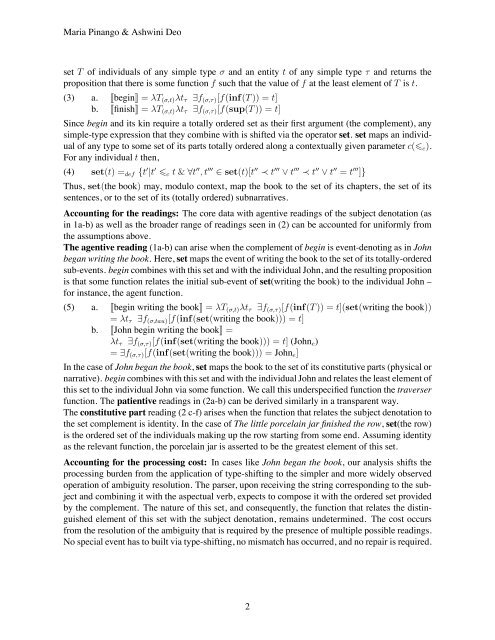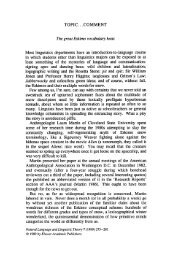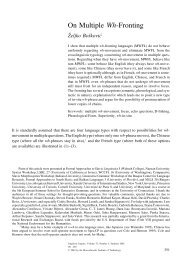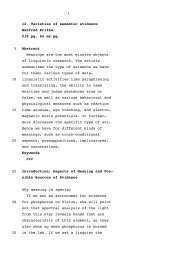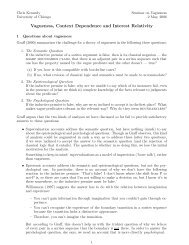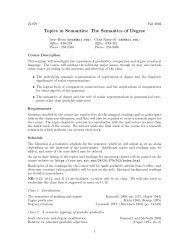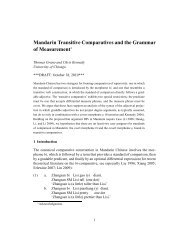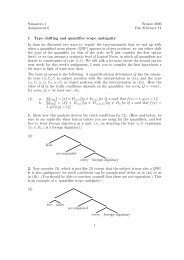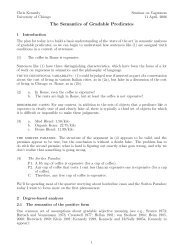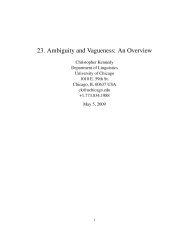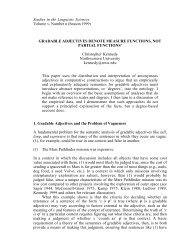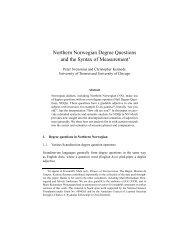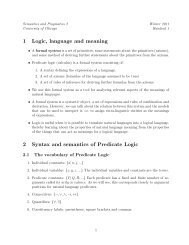On the natural history of negative polarity items - Syntax, Semantics ...
On the natural history of negative polarity items - Syntax, Semantics ...
On the natural history of negative polarity items - Syntax, Semantics ...
Create successful ePaper yourself
Turn your PDF publications into a flip-book with our unique Google optimized e-Paper software.
Maria Pinango & Ashwini Deo<br />
set T <strong>of</strong> individuals <strong>of</strong> any simple type σ and an entity t <strong>of</strong> any simple type τ and returns <strong>the</strong><br />
proposition that <strong>the</strong>re is some function f such that <strong>the</strong> value <strong>of</strong> f at <strong>the</strong> least element <strong>of</strong> T is t.<br />
(3) a. begin = λT(σ,t)λtτ ∃f(σ,τ)[f(inf(T )) = t]<br />
b. finish = λT(σ,t)λtτ ∃f(σ,τ)[f(sup(T )) = t]<br />
Since begin and its kin require a totally ordered set as <strong>the</strong>ir first argument (<strong>the</strong> complement), any<br />
simple-type expression that <strong>the</strong>y combine with is shifted via <strong>the</strong> operator set. set maps an individual<br />
<strong>of</strong> any type to some set <strong>of</strong> its parts totally ordered along a contextually given parameter c(c).<br />
For any individual t <strong>the</strong>n,<br />
(4) set(t) =def {t ′ |t ′ c t & ∀t ′′ ,t ′′′ ∈ set(t)[t ′′ ≺ t ′′′ ∨ t ′′′ ≺ t ′′ ∨ t ′′ = t ′′′ ]}<br />
Thus, set(<strong>the</strong> book) may, modulo context, map <strong>the</strong> book to <strong>the</strong> set <strong>of</strong> its chapters, <strong>the</strong> set <strong>of</strong> its<br />
sentences, or to <strong>the</strong> set <strong>of</strong> its (totally ordered) subnarratives.<br />
Accounting for <strong>the</strong> readings: The core data with agentive readings <strong>of</strong> <strong>the</strong> subject denotation (as<br />
in 1a-b) as well as <strong>the</strong> broader range <strong>of</strong> readings seen in (2) can be accounted for uniformly from<br />
<strong>the</strong> assumptions above.<br />
The agentive reading (1a-b) can arise when <strong>the</strong> complement <strong>of</strong> begin is event-denoting as in John<br />
began writing <strong>the</strong> book. Here,set maps <strong>the</strong> event <strong>of</strong> writing <strong>the</strong> book to <strong>the</strong> set <strong>of</strong> its totally-ordered<br />
sub-events. begin combines with this set and with <strong>the</strong> individual John, and <strong>the</strong> resulting proposition<br />
is that some function relates <strong>the</strong> initial sub-event <strong>of</strong> set(writing <strong>the</strong> book) to <strong>the</strong> individual John –<br />
for instance, <strong>the</strong> agent function.<br />
(5) a. begin writing <strong>the</strong> book = λT(σ,t)λtτ ∃f(σ,τ)[f(inf(T )) = t](set(writing <strong>the</strong> book))<br />
= λtτ ∃f(σ,tau)[f(inf(set(writing <strong>the</strong> book))) = t]<br />
b. John begin writing <strong>the</strong> book =<br />
λtτ ∃f(σ,τ)[f(inf(set(writing <strong>the</strong> book))) = t] (Johne)<br />
= ∃f(σ,τ)[f(inf(set(writing <strong>the</strong> book))) = Johne]<br />
In <strong>the</strong> case <strong>of</strong> John began <strong>the</strong> book, set maps <strong>the</strong> book to <strong>the</strong> set <strong>of</strong> its constitutive parts (physical or<br />
narrative). begin combines with this set and with <strong>the</strong> individual John and relates <strong>the</strong> least element <strong>of</strong><br />
this set to <strong>the</strong> individual John via some function. We call this underspecified function <strong>the</strong> traverser<br />
function. The patientive readings in (2a-b) can be derived similarly in a transparent way.<br />
The constitutive part reading (2 c-f) arises when <strong>the</strong> function that relates <strong>the</strong> subject denotation to<br />
<strong>the</strong> set complement is identity. In <strong>the</strong> case <strong>of</strong> The little porcelain jar finished <strong>the</strong> row, set(<strong>the</strong> row)<br />
is <strong>the</strong> ordered set <strong>of</strong> <strong>the</strong> individuals making up <strong>the</strong> row starting from some end. Assuming identity<br />
as <strong>the</strong> relevant function, <strong>the</strong> porcelain jar is asserted to be <strong>the</strong> greatest element <strong>of</strong> this set.<br />
Accounting for <strong>the</strong> processing cost: In cases like John began <strong>the</strong> book, ouranalysisshifts<strong>the</strong><br />
processing burden from <strong>the</strong> application <strong>of</strong> type-shifting to <strong>the</strong> simpler and more widely observed<br />
operation <strong>of</strong> ambiguity resolution. The parser, upon receiving <strong>the</strong> string corresponding to <strong>the</strong> subject<br />
and combining it with <strong>the</strong> aspectual verb, expects to compose it with <strong>the</strong> ordered set provided<br />
by <strong>the</strong> complement. The nature <strong>of</strong> this set, and consequently, <strong>the</strong> function that relates <strong>the</strong> distinguished<br />
element <strong>of</strong> this set with <strong>the</strong> subject denotation, remains undetermined. The cost occurs<br />
from <strong>the</strong> resolution <strong>of</strong> <strong>the</strong> ambiguity that is required by <strong>the</strong> presence <strong>of</strong> multiple possible readings.<br />
No special event has to built via type-shifting, no mismatch has occurred, and no repair is required.<br />
2


